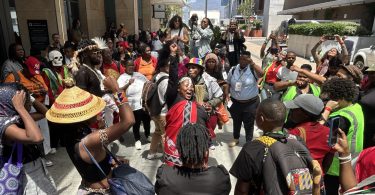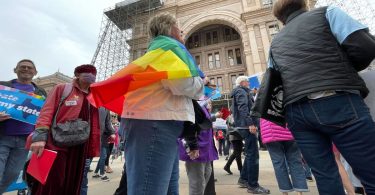Today marks the beginning of LGBTQ History Month, an annual month-long observance that provides role models, builds community, and represents a civil rights statement about the invaluable contributions of the LGBTQ community. Founded in 1994 by Rodney Wilson, a gay history teacher from rural Missouri, LGBTQ History Month was declared a national history month by President Barack Obama in 2009. This celebration coincides with National Coming Out Day (October 11) and commemorates the first and second marches on Washington for LGBTQ rights in 1979 and 1987.
Throughout October, GLAAD is spotlighting some of the countless unsung LGBTQ pioneers, changemakers, and trailblazers whose stories and achievements remain instrumental in understanding our shared history.
Alvin Ailey
Alivin Ailey grew up in the violently racist and segregated south, going on to become an incomparable dancer, a forward-facing visionary, and one of the most significant choreographers of the 20th century. After finding refuge in the church and moving to California, Ailey’s classmate and friend Carmen de Lavallade brought him to the studio of Lester Horton. At Horton’s company—one of the first racially integrated dance schools in the United States—Ailey studied a wide range of dance styles and techniques, eventually taking over as artistic director and choreographer after Horton’s sudden death. Following his Broadway debut, Ailey founded the Alvin Ailey American Dance Theater in 1958 to carry out his vision of a company dedicated to uplifting the African American experience while enriching and preserving the legacy of modern dance. In addition to establishing the Alvin Ailey American Dance Center (now The Ailey School) and the Alvin Ailey Repertory Ensemble (now Ailey II), Ailey also founded AileyCamp, a summer day camp for children to explore their creativity through dance and the arts. Ailey was awarded the highest distinctions in the arts, including the Kennedy Center Honors in 1988, before his untimely death a year later. In 2014, Ailey posthumously received the Presidential Medal of Freedom in recognition of his contributions and commitment to civil rights and dance in America. Last year, the Alvin Ailey American Dance Theater celebrated its 65th anniversary.
Angela Morley
A pioneering composer, conductor, orchestrator and performer, Angela Morley was the first out transgender person to be nominated for an Oscar. Morley was a multi-instrumentalist from a young age, playing piano, accordion and violin, before settling on the alto saxophone and clarinet. Morley left home to tour with Archie’s Juvenile Band at just 15 years old and by the time she was 20, Morley joined the Geraldo Orchestra, which was thought to be the best band in the UK at the time. Morley soon moved on to the next stage of her career, composing for television and feature films. In 1970, at the age of 46, Morley took two years away from the industry before publicly coming out as a transgender woman with the support of her second wife, Christine Parker. One of her first projects upon her return to the spotlight was aiding in the composition of the musical film The Little Prince, which was nominated for an Academy Award for Best Original Score. Morley was also the composer, conductor, arranger and orchestrator for the Sherman Brothers’ adaptation of the Cinderella story, The Slipper and the Rose: The Story of Cinderella. Though she was only credited as conductor and arranger, Morley was again nominated for Best Original Score. Later, Morley was nominated six times for Emmy Awards for composing, winning three for music direction. Today, Morley is commemorated by a Rainbow Plaque placed by Leeds Pride at the entrance of the BBC Leeds building, and also by a blue plaque at her birthplace in Kirkstall.
Brenda Howard
Known as the “Mother of Pride,” Brenda Howard was a radical bisexual+ rights activist, anti-war advocate and sex-positive feminist. One month after the Stonewall Uprising in 1969, LGBTQ activists—including Howard—organized the Christopher Street Liberation Day March. Howard then co-organized a week-long series of events to mark the anniversary of the Christopher Street Liberation Day March a year later. According to the Legacy Project, the celebration created a wave of parallel marches and parades across the world—similar to contemporary Pride marches. In 1987, Howard founded the New York Area Bisexual Network, which is a central communications network that still exists today. Ahead of the 1993 March on Washington, Howard was also part of the delegation that worked to get the word “bisexual” added to the marches’ title. In addition, Howard was an active member of the Gay Liberation Front, chair of the Gay Activists Alliance’s Speakers Bureau, and served on the Steering Committee of Stonewall 25. The year Howard passed away, the Queens, New York branch of PFLAG initiated the “Brenda Howard Award” in her honor—the first award given by a major U.S. LGTBQ organization to be named after an out bisexual+ person. Today, the award recognizes “an individual or organization that best exemplifies the vision, principals and community service exemplified by the late LGBTQ rights activist Brenda Howard and who serves as a positive and visible role model for the Bisexual Community.”
Edith Windsor
The youngest child of Russian Jewish immigrants during the Great Depression, Edith “Edie” Windsor was a computer programmer, mentor for women in tech, and revolutionary LGBTQ activist. After receiving a master’s degree in mathematics, Windsor began her career at IBM, eventually attaining the title designating the highest level technical position. Despite being known for her “top-notch debugging skills,” IBM rejected Windsor’s insurance form naming her partner Thea Spyer as a beneficiary. In 1975, Windsor became the founding president of the consulting firm PC Classics and helped numerous LGBTQ groups become tech literate while computerizing their mail systems. Though Windsor and Spyer’s marriage in Canada was recognized by the state of New York, upon Syper’s death in 2009, Windsor was not able to claim the estate tax marital deduction that was available to heterosexual surviving spouses. The following year, Windsor filed a lawsuit against the federal government to challenge the constitutionality of the “Defense Against Marriage Act” (DOMA), a federal statute that defined marriage as a legal union between one man and one woman as husband and wife. With a 5-4 majority decision, the landmark Supreme Court ruling made all married couples fully recognized by the federal government for taxes, Social Security benefits, immigration, and more. This case laid the foundation for the 2015 “Obergefell v. Hodges” decision, which made same-sex marriage legal in the United States. In 2016, Lesbians Who Tech launched the Edie Windsor Coding Scholarship Fund, which funds coding-school tuition for queer women and nonbinary people.
Gladys Bentley
A blues pianist, singer, performer, and drag king, Gladys Bentley was one of the most well-known and financially successful Black women in the United States throughout the 1920s and 1930s. At age 16, Bentley moved from Philadelphia to New York City to begin her career at Harry Hansberry’s Clam House, one of the city’s most notorious gay speakeasies. During the height of the Harlem Renaissance, Bentley was an out lesbian who performed in her signature tuxedo and top hat under the stage name Bobbie Minton, singing her own lyrics to popular tunes in a deep voice while flirting with women in the audience. In 1934, Bentley created her own musical revue with a chorus of eight male dancers in drag. As the prohibition era came to an end and public acceptance of queerness waned, Bentley moved to California, where her success picked up again during WWII with the expansion of gay bars on the West Coast. In 2016, musician Shirlette Ammons released the album Twilight for Gladys Bentley, which paid tribute to Bentley’s legacy and “reimagined” her relationship to hip hop culture. Today, Bentley is remembered as a model of resistance and a pioneer in pushing the envelope of gender, sexuality, class and race.
Jane Addams
A progressive social reformer, women’s suffragist and peace activist, Jane Addams was on the frontline of the settlement house movement in the late 19th and early 20th centuries. While Addams suffered from a congenital spinal defect due to a childhood case of tuberculosis, she dedicated her life to fighting for equity. In 1889, Addams and her then partner Ellen Gates Starr founded Hull House, the first settlement house in the United States, which provided resources to underserved communities in Chicago, including health services, libraries, and educational programs. By the 1900s, Addams was a founding member of the National Association for the Advancement of Colored People (1909), and the co-founder of the Women’s International League for Peace and Freedom (1915) and the American Civil Liberties Union (1920). In 1931, Addams became internationally respected for her peace activism during World War I, ultimately becoming the first American woman to win a Nobel Peace Prize. Today, the Jane Addams Peace Association aims to deepen understanding of peace and justice through reflection, dialogue and social action, and the Hull House Museum is a National Historic Landmark, serving as a memorial to Addams and other resident social reformers, many of whom were LGBTQ.
Kiyoshi Kuromiya
Born in a Japanese American internment camp during World War II, Kiyoshi Kuromiya was a committed civil rights, anti-war, LGBTQ and HIV/AIDS activist. While studying at the University of Pennsylvania, Kuromiya worked closely with Martin Luther King Jr. and instigated the largest anti-war demonstration in the school’s history. Kuromiya later co-founded the Gay Liberation Front (GLF) in Philadelphia, recruiting a diverse array of people who stood in solidarity with groups such as the Black Panther Party, where he represented the organization as an out gay delegate to the 1970 Convention. In the 1980s, Kuromiya founded the Philadelphia chapter of the AIDS Coalition to Unleash Power (ACT UP)—where he edited the first medical treatment and cultural competency guidelines for people living with HIV, produced by people living with HIV/AIDS—and the Critical Path AIDS Project, which provided comprehensive, reliable information and resources to thousands of people living with HIV around the world. By 1989, Kuromiya discovered that he was HIV-positive, emboldening him even further to work towards destigmatization. Today, The Critical Path Learning Center, an expansion of the AIDS Library and the Critical Path Project, is an educational commons and stigma-free space devoted to the intersection of health and literacy for the digital age.
Michael Dillon
Born in 1915 in England, Michael Dillon was a doctor, philosopher, poet and pioneer of trans healthcare. After graduating from Oxford University, Dillon began his groundbreaking transition and succeeded in getting his birth certificate changed to reflect his gender. In 1946, Dillon published the book “Self: A Study in Ethics and Endocrinology,” which laid the groundwork for modern transgender healthcare and is still referenced today for its insights. A few years later, Dillon became the first person to undergo gender affirming surgery, while himself training to become a doctor. In an effort to protect his privacy, Dillon then served as a ship’s surgeon in the British Merchant Navy, but was outed by the press in the late 1950s. Dillon found refuge in the practice of Buddhism, becoming a novice Buddhist monk in India before passing away at the age of 47. In 2016, Dillion’s 1962 autobiography “Out of the Ordinary: A Life of Gender and Spiritual Transitions”—completed only two weeks before his untimely death—was published posthumously.
Pedro Zamora
Pedro Zamora was born in Havana, Cuba in 1972 before immigrating to the United States at eight years old. Attempting to donate blood at seventeen, Zamora discovered that he was HIV positive and joined the Miami AIDS resource center, Body Positive, which motivated him to dedicate his life to raising awareness and educating his peers to help prevent the rise of HIV infection among teens. Soon, Zamora captivated the nation with his openness, compassion and charisma, making an appearance on a front page article of the Wall Street Journal and television screens, including an interview with Oprah Winfrey. In 1993, Zamora testified before Congress to advocate for HIV/AIDS education in schools, especially for Spanish-speaking communities. The following year, Zamora joined the third season of the MTV reality show The Real World [San Francisco], becoming the first reality TV personality to publicly share their HIV status. Throughout the show, Zamora spoke openly about being HIV positive while educating viewers and his housemates about LGBTQ issues. Viewers were also introduced to Zamora’s boyfriend Sean Sasser, another man of color living with HIV, in a historical commitment ceremony. Zamora passed away the morning after the final episode of The Real World aired, showing the world the firsthand consequences of HIV stigma and misinformation. In addition to numerous organizations and scholarships in Zamora’s name—including The Pedro Zamora Youth HIV Clinic, The Pedro Zamora Public Policy Fellowship, and more—the trailblazer has been inducted on the National LGBTQ Wall of Honor within the Stonewall National Monument in New York’s Stonewall Inn.
Tracey “Africa” Norman
Tracey “Africa” Norman, the first Black trans woman to achieve prominence in the fashion industry, has been a pioneer for trans people in the industry since the 1970s. Norman was discovered after being photographed by Irving Penn for Italian Vogue just three years after graduating high school. In 1975, Norman memorably appeared on the front of a box of Clairol hair dye, with the words “Born Beautiful,” which was sold in drug stores across the nation for six years. As she skyrocketed to fame, Norman was outed on set of Essence magazine and struggled to find work. Assuming that her modeling career was over, Norman entered the drag ball community, ultimately working with the ballroom house “House of Africa,” where she gained her iconic middle name. Influential in the scene due to her modeling skills, Norman was soon voted in as “mother” of the House and was inducted into the ballroom hall of fame in 2001. After a biographic piece was written about Norman in 2015 by New York Magazine’s digital fashion site “The Cut,” Clairol reached back out to her to become the face of their “Nice ‘n Easy Color As Real As You Are” campaign. The following year, Norman and Geena Rocero became the first two out transgender models to appear on the cover of an edition of Harper’s Bazaar. Today, Norman is celebrated as an early trailblazer by fellow trans stars, including Laverne Cox and Janet Mock!
We’wha
We’wha, a lhamana individual born around 1849 in what is today New Mexico, was a cultural ambassador, spiritual leader, and expert craftsperson who helped preserve the history, traditions, and knowledge of the Zuni people. As early as age three or four, community members recognized We’wha as Ihamana, a third gender role within the tribe that often held positions of honor in the community—predating the 1990 term “Two Spirit,” a modern umbrella to describe Indigenous people who fulfilled gender-variant roles in their cultures. We’wha received some instructions specific to men while also training under their female relatives, learning critical skills for traditionally male and female roles. They trained for years to master the elements of pottery and weaving during a period in which Pueblo textiles in the distinctive Zuni style flourished, becoming one of the first Zuni people to sell their work. We’wha was also a member of numerous Zuni societies, including the men’s kachina society, which performed ritual masked dances, and the medicine society, known as Beshatsilo:kwe. In 1886, We’wha made a lasting impression in Washington, DC when they met personally with President Grover Cleveland and gave presentations on Zuni culture and spirituality. Today, the Santa Fe Human Rights Alliance annually presents the “We’wha Award” to individuals who have made significant contributions to the LGBTQ community in New Mexico.
William Dorsey Swann
Born into slavery in Maryland in 1860, William Dorsey Swann was the first known person to identify as a “Queen of Drag” and the first American activist to lead a queer resistance group. In the 1880s, Swann began hosting private balls in Washington DC, which soon caught the attention of authorities. After being convicted on the false charge of “keeping a disorderly house” in 1896, Swann demanded (and was denied) a pardon from President Grover Cleveland for holding a drag ball. This act marked the earliest recorded American to take specific legal and political action to defend the queer community’s right to gather without the threat of criminalization, suppression, or police violence. Following Swann’s retirement from the drag scene, his little brother Daniel J. Swann continued the family tradition into the 1900s. Today, the houses of the contemporary ballroom scene maintain the same basic format as the House of Swann’s.
Follow along on GLAAD’s Instagram throughout LGBTQ History Month for these spotlights and more!







